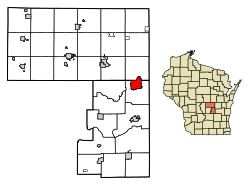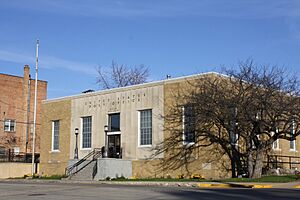Berlin, Wisconsin facts for kids
Quick facts for kids
Berlin, Wisconsin
|
|
|---|---|

Downtown Berlin
|
|
| Nickname(s):
fur and leather city
|
|

Location of Berlin in Waushara County (northern portion) and Green Lake County (southern portion), Wisconsin.
|
|
| Country | |
| State | |
| Counties | Green Lake, Waushara |
| Area | |
| • Total | 6.39 sq mi (16.55 km2) |
| • Land | 5.78 sq mi (14.97 km2) |
| • Water | 0.61 sq mi (1.58 km2) |
| Elevation | 807 ft (246 m) |
| Population
(2020)
|
|
| • Total | 5,571 |
| • Density | 931.34/sq mi (359.61/km2) |
| Time zone | UTC-6 (Central (CST)) |
| • Summer (DST) | UTC-5 (CDT) |
| Area code(s) | 920 |
| FIPS code | 55-06925 |
| GNIS feature ID | 1561600 |
Berlin is a city in Wisconsin, a state in the United States. It is located in both Green Lake and Waushara counties. In 2020, about 5,571 people lived there. Most of the city is in Green Lake County, with a small part in Waushara County.
Contents
History of Berlin
The first person to settle in what is now Berlin was Nathan H. Strong in 1845. Other early settlers joined him soon after. Their settlement was first called Strong's Landing.
In 1848, a post office was opened. The settlement was then named Berlin, after the capital city of Prussia (which is now Germany). The first school was built in 1850, and the first church in 1851. Berlin officially became a city in 1857.
The first commercial cranberry farms in Wisconsin started in the Berlin area. Also, the first factory in the Midwest to make condensed milk, the Carnation Company, was built here. For many years, from the 1860s to the 1990s, Berlin was known as "the fur and leather city." This was because of its important fur and leather industries. These industries created many jobs and attracted immigrants from countries like Scotland, Wales, Poland, and Italy.
How to Say "Berlin"
People who live in Berlin, Wisconsin, say the name with the accent on the first part: BUR-lin. This is different from how the capital of Germany is usually said (Ber-LIN). It's believed that the way people say it in Wisconsin changed during World War I. At that time, there was a lot of anti-German feeling in the United States. Before the war, the accent might have been on the second part of the name.
Geography of Berlin
The Fox River flows through the middle of Berlin, running from north to south.
The city covers a total area of about 6.36 square miles (16.5 square kilometers). Most of this area, about 5.78 square miles (14.97 square kilometers), is land. The rest, about 0.58 square miles (1.5 square kilometers), is water.
Population and People
| Historical population | |||
|---|---|---|---|
| Census | Pop. | %± | |
| 1860 | 1,449 | — | |
| 1870 | 2,777 | 91.6% | |
| 1880 | 3,353 | 20.7% | |
| 1890 | 4,149 | 23.7% | |
| 1900 | 4,489 | 8.2% | |
| 1910 | 4,636 | 3.3% | |
| 1920 | 4,400 | −5.1% | |
| 1930 | 4,106 | −6.7% | |
| 1940 | 4,247 | 3.4% | |
| 1950 | 4,693 | 10.5% | |
| 1960 | 4,838 | 3.1% | |
| 1970 | 5,338 | 10.3% | |
| 1980 | 5,478 | 2.6% | |
| 1990 | 5,371 | −2.0% | |
| 2000 | 5,305 | −1.2% | |
| 2010 | 5,524 | 4.1% | |
| 2020 | 5,571 | 0.9% | |
| U.S. Decennial Census | |||
In 2010, Berlin had 5,524 people living there. The city had 2,296 households. About 31.3% of these households had children under 18. The average age of people in Berlin was 39 years old. About 25.8% of the residents were under 18 years old.
Arts and Culture
Several places in Berlin are listed on the National Register of Historic Places. This means they are important historical sites that are protected.
- Beckwith House Hotel
- Berlin Post Office
- Huron Street Historic District
- Nathan Strong Park Historic District
- Nelson F. Beckwith House
- Old Berlin High School
- Wisconsin Power and Light Berlin Power Plant
Education in Berlin
The Berlin Area School District manages the schools in the city. All the main schools are on the same campus in Berlin. These include Clay Lamberton Elementary School, Berlin Middle School, and Berlin High School.
Media
Berlin has its own weekly newspaper called the Berlin Journal. There is also a local radio station, WISS (AM), located in Berlin.
Transportation
Berlin is served by two main state highways: Wisconsin Highway 49 and Wisconsin Highway 91. These roads help people travel in and out of the city.
Notable People from Berlin
Many interesting people have come from Berlin, Wisconsin. Here are a few:
- Nelson F. Beckwith – served in the Wisconsin State Assembly
- Fred Blair – ran for Wisconsin Governor and U.S. Senate
- William A. Bugh - a lawyer and Wisconsin State Assembly member
- Chris Greisen – played in the NFL (National Football League)
- Andy Jorgensen - served in the Wisconsin State Assembly
- William Nigh - an actor and director
- Luther Olsen - served as a Wisconsin State Senator
- Luther Reed - a screenwriter and film director
- Dora V. Wheelock (1847–1923) - a writer and activist for temperance
See also
 In Spanish: Berlin (Wisconsin) para niños
In Spanish: Berlin (Wisconsin) para niños


